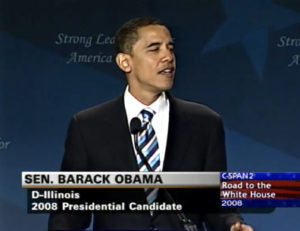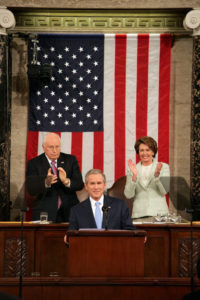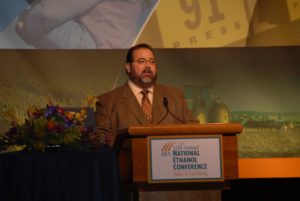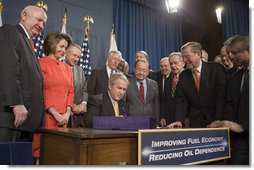New Year Gets in Gear with Goal to Increase RFS
On the very first day of the 110th Congress, Senators Tom Harkin (D-IA) and Richard Lugar (R-IN) re-introduced the Biofuels Security Act of 2007 which would amend the Clean Air Act and set new benchmarks for the Renewable Fuels Standard (RFS), reaching 30 billion gallons per year by 2020 and 60 billion gallons per year by 2030.
The legislation was also co-sponsored by Sen. Byron L. Dorgan (D-ND) and two future presidents: Senators Joseph R. Biden Jr. (D-DE) and Barack Obama (D-IL). From a press release announcing the bill:
“If it was not clear before, it is now: domestic energy policy is at the center of our foreign policy,” said Senator Biden. “For our own security – both nationally and globally — we have to begin the transition to alternative fuels. We can’t do that without upgrading to a better system that combines protection for U.S. automobile manufacturing jobs with increased use of alternative, home-grown fuels. We have no choice but to get smarter with our energy policy.”
“The Renewable Fuels Standard is one of the most significant steps taken by Congress to increase ethanol production and decrease our nation’s dangerous dependence on foreign oil,” Senator Obama said. “We should build off this success by increasing ethanol production, consumer access to renewable fuels, and the production of cars and trucks that can use them. It’s time for Congress to realize what farmers in America’s heartland have known all along – that we have the capacity and ingenuity to decrease our dependence on foreign oil by growing our own fuel, but what we’ve been lacking is the political will.”
 Less than a month later, Sen. Obama would be close to declaring his candidacy for president when he spoke to the winter meeting of the Democratic National Committee.
Less than a month later, Sen. Obama would be close to declaring his candidacy for president when he spoke to the winter meeting of the Democratic National Committee.
“In this primary everybody is going to have good ideas about how to achieve energy independence,” said Obama. “Some of us are going to talk about raising CAFE standards, others about biodiesel and ethanol, energy efficiency. We can have a vigorous, robust, honest debate but let’s agree that our dependence is a threat not only to our economy, not only to our national security, but also to the welfare of this planet, and let us pledge that there’s no reason why we can’t wean ourselves off Middle Eastern oil. We don’t need to send our young people to fight if we make sacrifices here at home.”
Ethanol Continues to Enjoy Bipartisan Support

President George W. Bush receives applause while delivering the State of the Union address at the U.S. Capitol, Tuesday, Jan. 23, 2007. Also pictured are Vice President Dick Cheney and Speaker of the House Nancy Pelosi. White House photo by David Bohre
As he did the year before, President George W. Bush devoted a significant portion of his 2007 State of the Union address to energy and to increasing the use of renewable fuel.
“For too long our nation has been dependent on foreign oil,” said President Bush. “It’s in our vital interest to diversify America’s energy supply. The way forward is through technology. We must continue investing in new methods of producing ethanol using everything from wood chips to grasses to agricultural wastes.”
The president called on Congress to reduce gasoline use in the United States by 20 percent in the next decade. “To reach this goal we must increase the supply of alternative fuels by setting a mandatory fuel standard to require 35 billion gallons of renewable and alternative fuels in 2017 – and that is nearly five times the current target.” That statement was met by a standing ovation led by a jubilant Senator Chuck Grassley from the number one ethanol producing state of Iowa.
In the Democratic response to the President’s address, Senator Jim Webb of Virginia began by saying that energy independence was one area where the Democrats agreed with the administration and that they looked forward to working with him on that issue. “(T)his is the seventh time the president has mentioned energy independence in his State of the Union message, but for the first time this exchange is taking place in a Congress led by the Democratic Party. We are looking for affirmative solutions that will strengthen our nation by freeing us from our dependence on foreign oil, and spurring a wave of entrepreneurial growth in the form of alternate energy programs. We look forward to working with the president and his party to bring about these changes.”
Soaring Above Nattering Nabobs of Negativity
As 2007 dawned upon the U.S. ethanol industry at the National Ethanol Conference in Tucson, Arizona, Renewable Fuels Association president and CEO Bob Dinneen said in his State of the Ethanol Industry address they could now envision a whole new horizon for growth.
 “The president suggests as much as 35 billion gallons of alternative fuel will be needed to displace 20% of our nation’s petroleum consumption by 2017,” said Dinneen. “The Governors’ Ethanol Coalition is promoting an initiative requiring 60 billion gallons of ethanol by 2030. Senator Dick Lugar has introduced legislation mandating 100 billion gallons of ethanol by 2030.”
“The president suggests as much as 35 billion gallons of alternative fuel will be needed to displace 20% of our nation’s petroleum consumption by 2017,” said Dinneen. “The Governors’ Ethanol Coalition is promoting an initiative requiring 60 billion gallons of ethanol by 2030. Senator Dick Lugar has introduced legislation mandating 100 billion gallons of ethanol by 2030.”
Dinneen acknowledged however that resistance to increased ethanol use was starting to become louder as the industry was getting bigger but said the industry needed to continue to meet arguments such as food vs. fuel with facts and reasonable dialogue. “We have met the nattering nabobs of negativity, and we have soared.”
Speakers at the conference included Department of Energy Assistant Secretary Alexander Karsner, EPA Administrator Stephen Johnson, and ethanol advocates in Congress Reps. Collin Peterson (D-MN) and Kenny Hulshof (R-MO).
In a rousing speech, Karsner talked about the commitment of the final two years of the Bush administration to increase use of renewable fuels. “We are ready to work with you, work across both aisles of Congress on a bipartisan basis to deliver monumental legislation that will fortify your industry for another generation … to make sure you are growing more profitable and in doing so bringing our nation and our planet into a healthier and more secure state of being.”
Both Karsner and Johnson noted the executive order signed by President Bush shortly after his State of the Union address in January that required the federal government to reduce its use of petroleum as a way to reach his 20% in ten years goal. “These measures include reducing total consumption of petroleum in fleet vehicles by two percent annually and increasing alternative fuel consumption by 10 percent annually,” Karsner said.

Reps. Collin Peterson on guitar and Kenny Hulshof on drums entertain at the 2007 National Ethanol Conference
Rep. Peterson also brought up some of the first concerns of livestock producers about the impact of ethanol production on feed prices, an issue which would become a tightrope for some lawmakers in states like Minnesota, a traditional dairy state that was taking a lead role in biofuels. It was also a state that was looking into developing distillers’ grains as a livestock feed ethanol co-product. “So, some of the research we’re going to do will focus on trying to improve the feed rations, pulling the protein and fiber out of the corn before it goes into ethanol,” said Peterson, who as chairman of the House Agriculture Committee was most concerned that year in Congress with negotiations for a new farm bill.
Hulshof noted that the road for ethanol’s acceptance had been a long one and there were still critics in the wings. “We’re still having to deal with studies, like the one from Cornell, that say that it costs more to produce a gallon of ethanol than it will save in energy,” Hulsof said.
RFS Final Rule Crosses Finish Line
 On April 10, 2007, three agencies of the federal government united to announce the establishment of the nation’s first comprehensive Renewable Fuel Standard (RFS) program.
On April 10, 2007, three agencies of the federal government united to announce the establishment of the nation’s first comprehensive Renewable Fuel Standard (RFS) program.
EPA Administrator Stephen Johnson, joined by Energy Secretary Samuel Bodman and National Highway Traffic Safety Administrator Nicole Nason, discussed the RFS program, increasing the use of alternative fuels and modernizing CAFÉ standards for cars.
“The Renewable Fuel Standard offers the American people a hat trick – it protects the environment, strengthens our energy security, and supports America’s farmers,” said EPA Administrator Stephen L. Johnson. “Today, we’re taking an important first step toward meeting President Bush’s “20 in 10” goal of jumping off the treadmill of foreign oil dependency.”
“Increasing the use of renewable and alternative fuels to power our nation’s vehicles will help meet the President’s Twenty in Ten goal of reducing gasoline usage by 20 percent in ten years,” Secretary Bodman said. “The Administration’s sustained commitment to technology investment will bring a variety of alternative fuel sources to market and further reduce our nation’s dependence on foreign sources of energy.”
“While we must look at increasing the availability of renewable and alternative fuels, we must also continue to improve the fuel efficiency of our passenger cars and light trucks,” said Nicole R. Nason, Administrator of the National Highway Traffic Safety Administration. “As a part of the President’s “20 in 10” energy security plan, we need Congress to give the Secretary of Transportation the authority to reform the current passenger car fuel economy standard.”
Renewable Fuels Association Chairman Ron Miller of Aventine Renewable Energy called the RFS “a watershed piece of legislation for the U.S. ethanol industry.”
“It has provided our industry a solid foundation from which to grow and the results speak for themselves. Today’s ethanol industry is supporting 160,000 new jobs, reducing greenhouse gas emissions and lessening our reliance on imported oil. The EPA and Administrator Johnson are to be commended for their efforts to get this program fully implemented.”
The final rule for RFS1 established detailed compliance standards for fuel suppliers, a tracking system based on renewable identification numbers (RINs) with credit verification and trading, provisions for treatment of small refineries, and general waiver provisions. The program officially began September 1, 2007 – just a little more than three months before Congress would pass a new energy bill with a vastly expanded RFS.
 2007 Energy Bill Takes a Victory Lap with Expanded RFS
2007 Energy Bill Takes a Victory Lap with Expanded RFS
President Bush signed the Energy Independence and Security Act into law on December 19, 2007, ushering in the new and improved Renewable Fuel Standard called RFS2.
“The bill I sign today takes a significant step because it will require fuel producers to use at least 36 billion gallons of biofuel in 2022,” said President Bush. “This is nearly a fivefold increase over current levels. It will help us diversify our energy supplies and reduce our dependence on oil.”
“The standard would create new markets for farm products used to produce these fuels. The standard would increase our energy security by making us less vulnerable to the instability of oil prices on the world market,” Bush added.
Speaker of the House Nancy Pelosi (D-CA) called the bill “groundbreaking in what it will do.”
Joining President Bush at the signing ceremony, Renewable Fuels Association President Bob Dinneen commented, “History will look back upon the enactment of the Energy Independence and Security Act of 2007 as the moment America chose a new energy policy path. By coupling increases in vehicle efficiency and renewable fuel use, America is taking the most immediate steps available that will have the greatest impact in securing a more sustainable energy and environmental future.”
EISA Details
 Congress included specific details in the new energy bill that would serve as a guide to regulators for the next 14 years.
Congress included specific details in the new energy bill that would serve as a guide to regulators for the next 14 years.
Amends the Clean Air Act to direct the EPA Administrator to revise regulations to ensure that domestic transportation fuel sold or introduced into commerce, on an annual average basis, contains a specified volume of renewable fuel, advanced biofuel, cellulosic biofuel, and biomass-based diesel, and, in the case of renewable fuel produced from new facilities that commence construction after enactment of this Act, achieves at least a 20% reduction in lifecycle greenhouse gas emissions compared to certain baseline lifecycle greenhouse gas emissions.
Revises the applicable volumes of renewable fuel required for calendar years 2008 through 2012 gasoline sold or introduced into commerce in the United States (except in noncontiguous states or territories), on an annual average basis. Specifies such volumes for calendar years 2013 through 2022. Applies such applicable volumes to advanced biofuel, cellulosic biofuel, and biomass-based diesel for certain of these years.
Direction was also give to the Department of Energy to take actions such as developing a consumer education program on the benefits of alternative fuel in automobiles, extending the flexible fuel vehicle credit program through model year 2019, and providing grants for research and development of biofuels and cellulosic ethanol in particular. It also directed the Secretary of Energy to “assess the impact of renewable fuel program requirements on each industry regarding production of feed grains, livestock, food, forest products, and energy.”
Like the previous energy bill, all of its provisions would now enter into the implementation process, but as the industry entered 2008, optimism was at an all time high.
“This really is a Christmas gift to the American people because what this means in terms of economic development, what this means in terms of energy security, what this means in terms of finally addressing the challenge of global climate change, what this means in terms of moderating gasoline price,” said RFA’s Bob Dinneen in one of the first-ever industry podcasts. “A lot of people have questioned whether or not we’re going to be able to meet the 36 billion gallons of ethanol and other biofuels by 2022…I view that with some irony because there were a lot of people that were questioning whether or not the ethanol industry would be able to build 7 and a half billion gallons by 2012, and whether or not we would be able to meet the targets established in the 2005 bill. And what we demonstrated was you give the marketplace a clear signal and the marketplace will respond because we not only met that 7 1/2 billion target before 2012, we met it before 2008.”